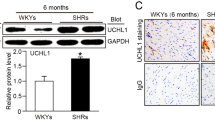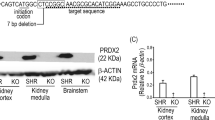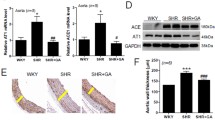Abstract
Human essential hypertension is a complex polygenic trait with underlying genetic components that remain unknown. The spontaneously hypertensive rat (SHR) is a well-characterized experimental model for essential hypertension. By comparative proteomics, we previously identified glutathione S-transferase, mu 2 (GSTM2), a protein involved in detoxification of reactive oxygen species, which had a significant reduction in left ventricles of 16-week-old SHR compared with WKY rats. In parallel, Western blotting and RT-PCR showed a similar reduction of GSTM2 in left ventricles and aortas of 4-, 8-, and 16-week-old SHR, which is before the onset of hypertension. This suggests that differential expression is not attributable to long-term changes in blood pressure. Meanwhile, the activities of GSTM2 were significantly decreased in different ages old SHR. Conversely, there was an enhanced generation of superoxide anion and activation of NADPH oxidase in SHR, which was accompanied by an increase in the protein expression of p47phox, a subunit of NADPH oxidase. These data suggest that it maybe a reduction in antioxidant defenses, evident by a reduced expression and activity of GSTM2, in the left ventricles and aortas of SHR that leads to increased levels of superoxide anion and activation of NADPH oxidase.








Similar content being viewed by others
References
Pereira LM, Mandarim-de-Lacerda CA (2001) Stereology of cardiac hypertrophy induced by NO blockade in rats treated with enalapril and verapamil. Anal Quant Cytol Histol 23:330–338
Ito N, Nitta Y, Ohtani H et al (1994) Remodelling of microvessels by coronary hypertension or cardiac hypertrophy in rats. J Mol Cell Cardiol 26:49–59
Okamoto K, Aoki K (1963) Development of a strain of spontaneously hypertensive rats. Jpn Circ J 27:282–293
Hu WY, Han YJ, Gu LZ et al (2007) Involvement of Ras-regulated myosin light chain phosphorylation in the captopril effects in spontaneously hypertensive rats. Am J Hypertens 20:53–61
Rothermund L, Paul M (1998) Hypertension and the rennin angiotensin system evidence from genetic and transgenic studies. Basic Res Cardiol 93:1–6
Rysa J, Leskinen H, Ilves M et al (2005) Distinct upregulation of extracellular matrix genes in transition from hypertrophy to hypertensive heart failure. Hypertension 45:927–933
Mitchell GF, Pfeffer JM, Pfeffer MA (1997) The transition to failure in the spontaneously hypertensive rat. Am J Hypertens 10:120S–126S
Zhou SG, Zhou SF, Huang HQ et al (2006) Proteomic analysis of hypertrophied myocardial protein patterns in renovascularly hypertensive and spontaneously hypertensive rats. J Proteome Res 5:2901–2908
McBride MW, Carr FJ, Graham D et al (2003) Microarray analysis of rat chromosome 2 congenic strains. Hypertension 41:847–853
Hayes JD, Pulford DJ (1995) The glutathione S-transferase supergene family: regulation of GST and the contribution of the isoenzymes to cancer chemoprotection and drug resistance. Crit Rev Biochem Mol Biol 30:445–600
Hurst R, Bao Y, Jemth P et al (1998) Phospholipid hydroperoxide glutathione peroxidase activity of human glutathione transferases. Biochem J 332:97–100
Sharma R, Yang Y, Sharma A et al (2004) Antioxidant role of glutathione S-transferases: protection against oxidant toxicity and regulation of stress-mediated apoptosis. Antioxid Redox Signal 6:289–300
Lacy F, O’Connor DT, Schmid-Schonbein GW (1998) Plasma hydrogen peroxide production in hypertensives and normotensive subjects at genetic risk of hypertension. J Hypertens 16:291–303
Russo C, Olivieri O, Girelli D et al (1998) Anti-oxidant status and lipid peroxidation in patients with essential hypertension. J Hypertens 16:1267–1271
Redon J, Oliva MR, Tormos C et al (2003) Antioxidant activities and oxidative stress byproducts in human hypertension. Hypertension 41:1096–1101
Chan SH, Tai MH, Li CY et al (2006) Reduction in molecular synthesis or enzyme activity of superoxide dismutases and catalase contributes to oxidative stress and neurogenic hypertension in spontaneously hypertensive rats. Free Radic Biol Med 40:2028–2039
Kerr S, Brosnan MJ, McIntyre M et al (1999) Superoxide anion production is increased in a model of genetic hypertension: role of the endothelium. Hypertension 33:1353–1358
Swei A, Lacy F, Delano FA et al (1999) A mechanism of oxygen free radical production in the Dahl hypertensive rat. Microcirculation 6:179–187
Bishop JE, Kiernan LA, Montgomery HE et al (2000) Raised blood pressure, not rennin–angiotensin systems, causes cardiac fibrosis in TGR m(Ren2)27 rats. Cardiovasc Res 47:57–67
Del Monte F, Butler K, Boecker W et al (2002) Novel technique of aortic banding followed by gene transfer during hypertrophy and heart failure. Physiol Genomics 9:49–56
Kuo WH, Chou FP, Young SC et al (2005) Geniposide activates GSH S-transferase by the induction of GST M1 and GST M2 subunits involving the transcription and phosphorylation of MEK-1 signaling in rat hepatocytes. Toxicol Appl Pharmacol 208:155–162
Habig WH, Pabst MJ, Jakoby WB (1974) The first enzymatic step in mercapturic acid formation. J Biol Chem 249:7130–7139
Cifuentes ME, Rey FE, Carretero OA et al (2000) Upregulation of p67phox and gp91phox in aortas from angiotensin II-infused mice. Am J Physiol Heart Circ Physiol 279:H2234–H2240
Jalil JE, Perez A, Ocaranza MP et al (2005) Increased aortic NADPH oxidase activity in rats with genetically high angiotensin converting enzyme levels. Hypertension 46:1362–1367
Tarpey MM, Wink DA, Grisham MB (2004) Methods for detection of reactive metabolites of oxygen and nitrogen: in vitro and in vivo considerations. Am J Physiol Regul Integr Comp Physiol 286:R431–R444
Virdis A, Neves MF, Amiri F et al (2004) Role of NAD(P)H oxidase on vascular alterations in angiotensin II-infused mice. J Hypertens 22:535–542
Van Heerebeek L, Meischl C, Stooker W et al (2002) NADPH oxidase(s): new source(s) of reactive oxygen species in the vascular system? J Clin Pathol 55:561–568
Lassegue B, Clempus RE (2003) Vascular NAD(P)H oxidases: specific features, expression, and regulation. Am J Physiol Regul Integr Comp Physiol 285:R277–R297
Lambeth JD (2004) NOX enzymes and the biology of reactive oxygen. Nat Rev Immunol 4:181–189
Touyz RM, Yao G, Schiffrin EL (2003) c-Src induces phosphorylation and translocation of p47phox: role in superoxide generation by angiotensin II in human vascular smooth muscle cells. Arterioscler Thromb Vasc Biol 23:981–987
Zhao T, Singhal SS, Piper JT et al (1999) The role of human glutathione S-transferases hGSTA1-1 and hGSTA2-2 in protection against oxidative stress. Arch Biochem Biophys 367:216–224
Hayes JD, McLellan LI (1999) Glutathione and glutathione-dependent enzymes represent a coordinately regulated defence against oxidative stress. Free Radic Res 31:273–300
Hamilton CA, Brosnan MJ, McIntyre M et al (2001) Superoxide excess in hypertension and aging: a common cause of endothelial dysfunction. Hypertension 37:529–534
Sawyer DB, Siwik DA, Xiao L et al (2002) Role of oxidative stress in myocardial hypertrophy and failure. J Mol Cell Cardiol 34:379–388
Moreau P, Tea BS, Dam TV et al (1997) Altered balance between cell replication and apoptosis in hearts and kidneys of newborn SHR. Hypertension 30:720–724
Acknowledgements
This work was supported by the National Natural Science Fund of PR of China (No.: 30472022), Major program in key field of people’s government of GuangDong province, PR of China (No.: 2003A30904), Doctor’s scientific research start fund of GuangDong Pharmaceutical University, PR of China (No.: 43540140), and Medical scientific research fund of GuangDong province, PR of China (No.: A2007309).
Author information
Authors and Affiliations
Corresponding author
Rights and permissions
About this article
Cite this article
Zhou, SG., Wang, P., Pi, RB. et al. Reduced expression of GSTM2 and increased oxidative stress in spontaneously hypertensive rat. Mol Cell Biochem 309, 99–107 (2008). https://doi.org/10.1007/s11010-007-9647-7
Received:
Accepted:
Published:
Issue Date:
DOI: https://doi.org/10.1007/s11010-007-9647-7




